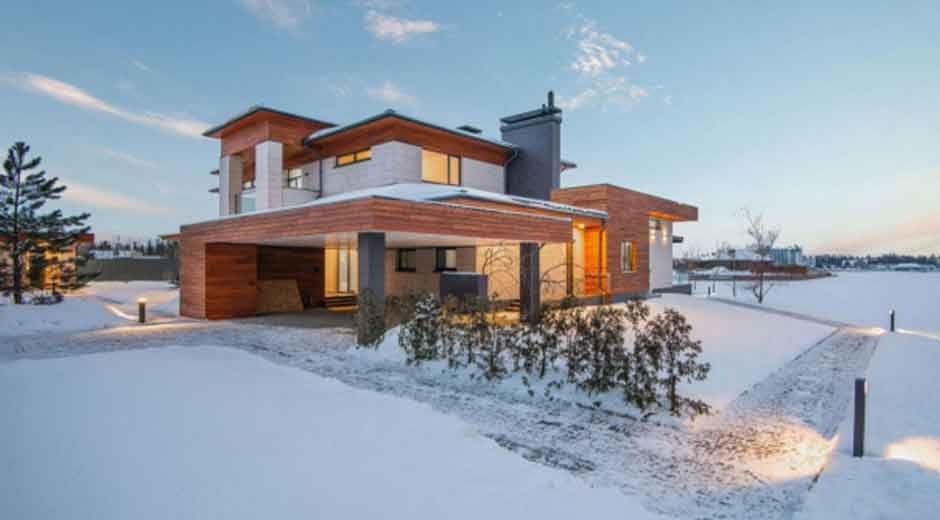When the weather turns colder, the last thing you want is a cold draft creeping through your home or a surprise heating breakdown in the middle of the night. Winter has a way of catching people off guard, but prepping your house doesn’t have to be complicated or time-consuming.
With just a few simple steps, you can keep your home warm, safe, and efficient all season long. The best part? You don’t need to be an expert or spend a fortune to do it. Let’s walk through exactly what to do.
1. Reverse Ceiling Fans
This might seem like a small step, but it makes a difference. Most ceiling fans have a switch that lets you reverse the direction of the blades. In winter, you want the blades spinning clockwise on a low setting. This helps push warm air— which naturally rises—down into the room.
You’ll feel warmer without having to turn up the heat. It’s especially helpful in rooms with high ceilings or where heat tends to collect near the ceiling. If your fan has a remote or smart control, switching the direction may be as simple as tapping a button. Make it a habit to check this each season.
2. Make Sure Your Heating System Is Ready
Before winter really kicks in, your heating system needs a little attention. A well-maintained heater not only works better but also uses less energy, saving you money on your utility bills. One of the smartest things you can do before the cold sets in is schedule your annual heating maintenance. It helps your system run safely and efficiently all winter.
During this check, a technician will inspect your system for worn parts, clean the internal components, check your thermostat, and ensure everything is running as it should. They’ll also let you know if any small issues should be fixed before they turn into bigger problems.
3. Seal Windows and Doors
If your home always feels a little drafty, your windows and doors might be to blame. Even small gaps around frames can let warm air out and cold air in, making your heating system work harder than it needs to.
Check for any cracks or spaces around window edges and door frames. You can use weather stripping, caulk, or even temporary insulation kits to seal things up. These materials are easy to apply and available at most home improvement stores.
Also, check the bottom of exterior doors. If there’s a gap, a door sweep can help keep the cold out and the warm air in. It’s a quick fix with a big payoff. For older windows, consider using thermal curtains for extra insulation.
4. Insulate Exposed Pipes
Frozen pipes can be a serious problem. If they burst, you could be looking at costly repairs and water damage. Pipes in unheated areas like basements, garages, or crawl spaces are most at risk, especially when temperatures stay below freezing for several days in a row.
To protect your plumbing, wrap any exposed pipes in foam pipe insulation. It’s affordable, easy to install, and available at most hardware stores. You don’t need any tools—just cut it to size and slide it on. For added protection, especially in very cold climates, you can also use heat tape made specifically for pipes.
It’s also a good idea to keep your cabinet doors open on very cold nights, especially if your kitchen or bathroom sink pipes are along exterior walls. This allows warmer indoor air to circulate around the pipes.
5. Clean Gutters and Downspouts
When leaves pile up in your gutters, they can stop water from draining properly. That water can freeze in winter, creating heavy ice dams that damage your roof, siding, or foundation. Cleaning your gutters before the first freeze helps prevent all that.
Use a ladder and gloves to clear out leaves and debris. Don’t forget to check the downspouts as well. If they’re clogged, water won’t flow away from your house like it should. Make sure everything is clear so rain and melting snow can drain safely.
While you’re up there, it’s also a good time to check your roof for missing shingles or signs of wear.
6. Check Smoke and Carbon Monoxide Detectors
Your heating system runs more in winter. You’re also more likely to use things like fireplaces and space heaters. That’s why it’s so important to make sure your smoke and carbon monoxide detectors are working properly.
Go through your home and test each one. Change the batteries if needed, and replace any detector that’s more than 10 years old. If you don’t already have a carbon monoxide detector, now’s the time to install one, especially if you use gas heating. It’s a small step that could save lives.
You should have detectors on every level of your home, especially near bedrooms. Don’t skip this step—it takes just a few minutes and can offer real peace of mind.
7. Cover Outdoor Faucets and Store Hoses
Water left in outdoor pipes can freeze and cause them to crack or burst. Before it gets too cold, disconnect your garden hoses, drain them, and store them inside your garage or shed.
Then, cover your outdoor faucets with foam faucet covers. These help insulate the fixture and prevent freezing. If your house has a shut-off valve for exterior faucets, be sure to close it and fully drain the connected water lines to prevent freezing.
Also, remember to bring in any outdoor sprinklers, nozzles, or irrigation timers. Storing them indoors keeps them from getting damaged and extends their lifespan.
When you take time to winterize your home, you’re doing more than just protecting it from the cold. You’re creating a more comfortable space, avoiding unexpected repairs, and even saving money on your energy bills. None of these steps are hard, but together they make a big difference.
Start with what’s easiest for you. If your schedule’s tight, knock out one or two tasks each weekend. Before you know it, your home will be ready for whatever winter brings. And once the snow starts falling, you’ll be glad you planned ahead.






